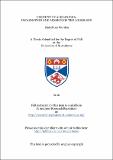Files in this item
Clement of Alexandria : Incarnation and mission of the Logos-Son
Item metadata
| dc.contributor.advisor | Davila, James R. | |
| dc.contributor.advisor | Wolfe, B. N. (Brendan N.) | |
| dc.contributor.author | Worden, Daniel Lee | |
| dc.coverage.spatial | x, 270 p. | en_US |
| dc.date.accessioned | 2018-11-19T14:38:29Z | |
| dc.date.available | 2018-11-19T14:38:29Z | |
| dc.date.issued | 2016-11-30 | |
| dc.identifier.uri | https://hdl.handle.net/10023/16500 | |
| dc.description.abstract | Clementine scholarship acknowledges Clement’s doctrine of the Incarnation and generally maintains that for Clement the divine Logos assumed human flesh. However, because of Clement’s complex logology and three passages suggesting a docetic interpretation of Christ’s flesh, scholars tend to move away from addressing the Incarnation and treat either the metaphysics of the multiple logoi theory or the question of Clement’s Docetism, or both. Because of this diversion in research, there remains a gap in the literature around Clement’s teachings about the Incarnation. This thesis begins to fill the gap by explaining Clement’s view of the Incarnation, which he connects to the emergent ‘exchange’ doctrine, envisaged as a divine mission. It situates Clement as an heir of the apostolic tradition while he engages with Greek philosophy and Gnostic belief. The research delineates Clement’s gnostic tradition, which he considered faithful to the Old Testament and to the teachings of the apostles. The investigation collates Clement’s usage of John 1:14 and the term ginomai linked with Logos, anthropos, and sarx. It examines Clement’s discussion in Stromateis VII.2, where he claims the Logos assumed flesh susceptible to suffering, emotions, and physical sensibilities. In Clement’s teachings, the Logos became both anthropos and sarx so that anthropos might become theos. This thesis outlines Clement’s usage of the terms parousia and epiphaneia (appearing), showing they are consequential to the Incarnation. Clement presents the Logos as Saviour, who conquers malevolent powers and death to release humankind from corruption through his sufferings from birth to the cross. Clement also presents the Logos as a Teacher, who during his parousia, interprets precisely the Old Testament, and in his appearing, discloses true gnosis, which guides anthropos to godliness. The evidence demonstrates that Clement bases his path for assimilation to God upon the Incarnation of the Logos. | en_US |
| dc.language.iso | en | en_US |
| dc.publisher | University of St Andrews | |
| dc.subject | Clement of Alexandria | en_US |
| dc.subject | Incarnation | en_US |
| dc.subject | Exchange formula | en_US |
| dc.subject | Platonism and Gnosticism | en_US |
| dc.subject | Theology | en_US |
| dc.subject | Demiurge | en_US |
| dc.subject | Anthropogony | en_US |
| dc.subject | Soteriology | en_US |
| dc.subject | Epistle of Barnabas | en_US |
| dc.subject | Clement of Rome | en_US |
| dc.subject | Apostolic tradition and Gnostic tradition | en_US |
| dc.subject | Docetism | en_US |
| dc.subject | Saviour and teacher | en |
| dc.subject | Prophets | en |
| dc.subject | Propaideia | en |
| dc.subject | Gospel | en |
| dc.subject | Gnosis | en |
| dc.subject | The preaching of Peter | en |
| dc.subject | The Nag Hammadi Library | en |
| dc.subject.lcc | BR1720.C6W7 | |
| dc.title | Clement of Alexandria : Incarnation and mission of the Logos-Son | en_US |
| dc.type | Thesis | en_US |
| dc.type.qualificationlevel | Doctoral | en_US |
| dc.type.qualificationname | PhD Doctor of Philosophy | en_US |
| dc.publisher.institution | The University of St Andrews | en_US |
This item appears in the following Collection(s)
Items in the St Andrews Research Repository are protected by copyright, with all rights reserved, unless otherwise indicated.

